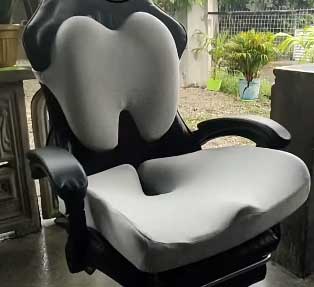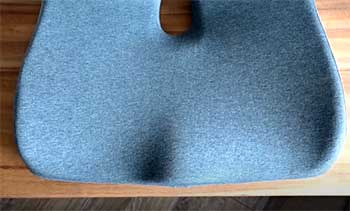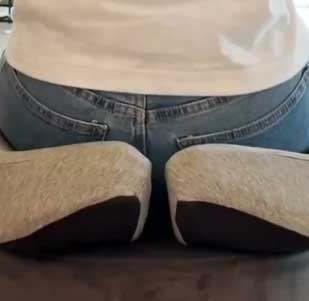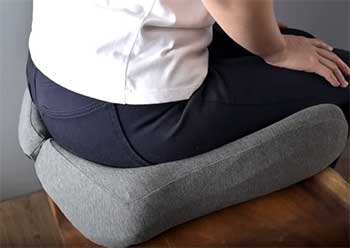If you’re searching for a comfortable seat cushion to ease back pain, improve posture, or simply make sitting at a desk or in your car more enjoyable, the OrthoCloud and Cushion Lab seat cushions are two popular options to consider.
But how do you know which one is the better choice for your needs? We’ll compare the key features, pros and cons of each below to help you decide.
A Brief Comparison Table
| OrthoCloud | Cushion Lab |
| Unique air cell technology allows cushion to contour to body | Uses high-density memory foam for conforming support |
| Focused on reducing and preventing back pain | Aims to relieve pressure and enhance comfort |
| Higher price point | Typically more budget-friendly |
| Automated inflation | Requires manual adjustment |
| 2 year warranty | 1 year warranty |
Overview of OrthoCloud

The OrthoCloud seat cushion aims to provide customized support and optimal spinal alignment through an innovative air cell technology.
Hundreds of interconnected air cells automatically sense pressure and inflate or deflate to contour perfectly to your body’s shape.
This helps keep your spine properly aligned and weight evenly distributed in any sitting position.
OrthoCloud boasts that its dynamic cushioning system reduces back pain and discomfort by 85% thanks to the reactive air cells molding to your body. The air cell grid also helps minimize pressure points that can reduce blood flow and cause numbness or pain when sitting for extended periods.
In addition to back support, OrthoCloud touts features like improved posture, tailbone pain relief, and enhanced comfort while sitting at a desk, driving, or traveling thanks to its automated inflation that requires no manual pumping or adjustments on your end.
Overview of Cushion Lab
The Cushion Lab seat cushion provides comfortable, supportive seating through its molded high-density memory foam construction. The contours and shape are designed to conform to the contours of your body and promote good posture and spinal alignment.
Unlike OrthoCloud’s automated air cells, Cushion Lab uses advanced memory foam that physically molds to your body shape thanks to your body heat and weight. This helps stabilize and align the spine for pain prevention and relieve pressure points that can cause discomfort when sitting for long periods.
While Cushion Lab may not customize itself to your exact body proportions like OrthoCloud, it does aim to provide ergonomic support for the average user to enhance comfort, reduce fatigue, and improve circulation and mobility.
Key Feature Comparison
Now that we’ve covered the basics of what each seat cushion aims to provide, let’s compare some of their key features and technologies:
Customized Support
- OrthoCloud’s hundreds of interconnected air cells automatically inflate and deflate to match the exact contours of your body, creating customized back support.
- Cushion Lab uses pre-molded memory foam that conforms to the average body shape to provide ergonomic support.
Pain and Pressure Relief
- Both cushions aim to align the spine, relieve pressure points, and reduce back pain and discomfort from sitting.
- OrthoCloud’s cells adapt in real time as you shift positions. Cushion Lab supports but doesn’t actively reshape itself like OrthoCloud.
Convenience
- OrthoCloud automatically inflates and deflates as needed to custom fit your body. No manual adjustments needed.
- Cushion Lab’s memory foam is heat and weight responsive but doesn’t actively reshape itself. Requires occasional fluffing to restore shape.
Portability
- Both cushions are lightweight and compressible for use in office chairs, car seats, wheelchairs etc.
- OrthoCloud’s air inflation system makes it slightly easier to transport than memory foam.
Durability
- Well maintained, both last 1-3 years with average daily use before losing support.
- Memory foam breaks down faster than air cells with regular use.
Posture Patrol

- OrthoCloud – 10/10: Consider OrthoCloud your new chiropractor, perpetually nudging you back into healthy spinal alignment as you shift to type, chat on your phone, or peer down editing photos. The ever-attentive air cells are on posture patrol 24/7!
- Cushion Lab 8/10: While you avoid the forward slump thanks to Lab’smulti layered padding proactively angling your spine right, their foam can flatten slightly overtime, allowing subtle stooping after months of all-day use.
Pain Prevention
- OrthoCloud 9/10: By cushioning your full cheek span rather than targeting solely the tailbone, OrthoCloud lifts all pressure points known to trigger lower back and sciatic woes over long sessions. Just mind slipping fingers to redistrib foam clumps after the occasional errant over-deflation.
- Cushion Lab 8/10: While those same pain trigger points get ample reinforcement from their compact support foam, the thin memory foam comfort layer up top may start to compact after months of daily driving or desk sitting. Simply stand and periodically punch to restore!
Mobility Maven
When your work or play demands frequent relocation, hoofing around your back relief adds hassle. Let’s compare cushion luggage abilities:
OrthoCloud 8/10: Compact and rollable thanks to OrthoCloud’s air-filled construction, you can conveniently stuff this seat-saver nearly anywhere, from packed suitcases to crowded bleachers with little struggle. Just give those cells a quick manual puff back up once unpacked.
Cushion Lab 5/10: Even the best quality foam still flops and drapes over time, making Lab’s cushion slightly trickier to freely ferry compared to OrthoCloud’s structured air pockets during transport. Expect a little extra finagling and fold smushing if space squeezed.
Longevity
Which cushion stays loyally by your side longest before turning lumpy traitor? Let’s table their relative expiration dates:
- OrthoCloud – 2-4 years if no errant punctures release its bouncy magic. Handle gently near sharp objects to protect its air cell souls!
- Cushion Lab – 1-2 years before indents don’t fully bounce back. Save your receipt for easy returns if it goes flat prematurely.
Budget Babysitter

We all crave custom tush coddling but financial realities may prioritize penny pinching for some.
Let’s pit their price tags:
- OrthoCloud – $200+ given their tech investment and niche market corner means no bargain bin status yet for these cellular seat savers.
- Cushion Lab – $40-$80 thanks to cost friendly foam and direct sales, Cushion Lab offers far friendlier prices for fine rear respite.
OrthoCloud Pros and Cons
Pros
- Customized spinal support and alignment from reactive air cell technology
- Conforms to your exact body shape and sitting preferences
- Automated – no manual adjustments needed
- Actively reshapes itself as you shift positions
- Reduces back pain and discomfort
- Minimizes pressure points
- Improves posture and blood flow
- Portable and easy to transport
- 2 year warranty
Cons
- One of the more expensive seat cushions
- Air cells may deflate over time and need replacement
- Not quite as soft and plush as memory foam
- Can feel unusual at first until customized
- Heavy users may experience faster breakdown
Cushion Lab Pros and Cons
Pros

- Comfortable, supportive memory foam conforms to body
- Provides stable spinal alignment for many users
- Alleviates tailbone pressure and back pain
- Enhances circulation and mobility
- Machine washable cover
- More affordable price point
- 1 year warranty
Cons
- Foam can flatten with extended use, reducing support
- Doesn’t customize itself to match exact body shape
- May feel too hard or soft for some users’ preferences
- Can absorb heat and moisture over time
- Shorter 1 year warranty period
- Not as reactive and self-regulating as OrthoCloud
Frequently Asked Questions (FAQ)
Yes, the Cushion Lab is a legitimate US-based company selling valid products. They specialize in seat cushions and pillows using memory foam and other materials to provide comfortable, supportive seating options. While not as technologically advanced as some competitors, their affordable cushions do help many users align their spines, improve posture, and enhance sitting comfort.
The “most comfortable” cushion is largely subjective and depends on your specific needs and preferences. But many users find seat cushions with responsive technologies like memory foam or OrthoCloud’s air cells to be most comfortable because they contour to your exact body shape rather than making you conform to their static shape. Maintaining spinal alignment is also key for comfort.
The best cushion support evenly distributes your weight so no single area bears too much pressure, aligns your spine in its natural position to avoid hunching or slouching, and responds dynamically to your micro-movements so you stay supported whether sitting upright, leaning forward, or shifting positions. Cushions like the OrthoCloud provide some of the best support due to the automatically customizing air cells.
Cushion Lab offers both large and regular sizing for broader coverage or a more petite frame. Measure the width of the chair you’ll use it on and go from there. If multiple people will share the cushion, size up. And if you have wider hips or spending longer periods sitting, the large size helps disperse pressure. But the regular works fine for average frames sitting intermittently. Consider your usage and body shape. Either way, make sure your full thighs and rear evenly contact the cushion’s surface.
The Bottom Line
While both companies aim to enhance sitting comfort and back support, OrthoCloud’s uniquely automated air cell technology gives it an edge in providing customized, dynamic spinal alignment and pain relief.
But Cushion Lab remains a quality, affordable option using supportive memory foam in an ergonomic design.
Think about your budget, sensitivities, usage, and key problems needing relief. Do you want cushy yet static memory foam support or air cells actively customizing themselves to your every subtle shift? There’s no universally “best” option.
But by understanding these seat cushions’ key functions, materials, and technologies, you can determine the better choice to meet your needs!

